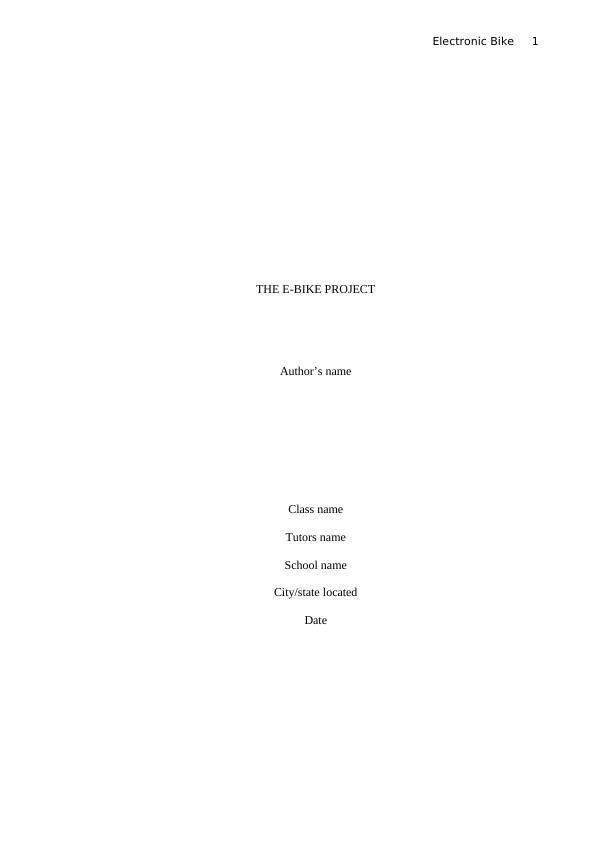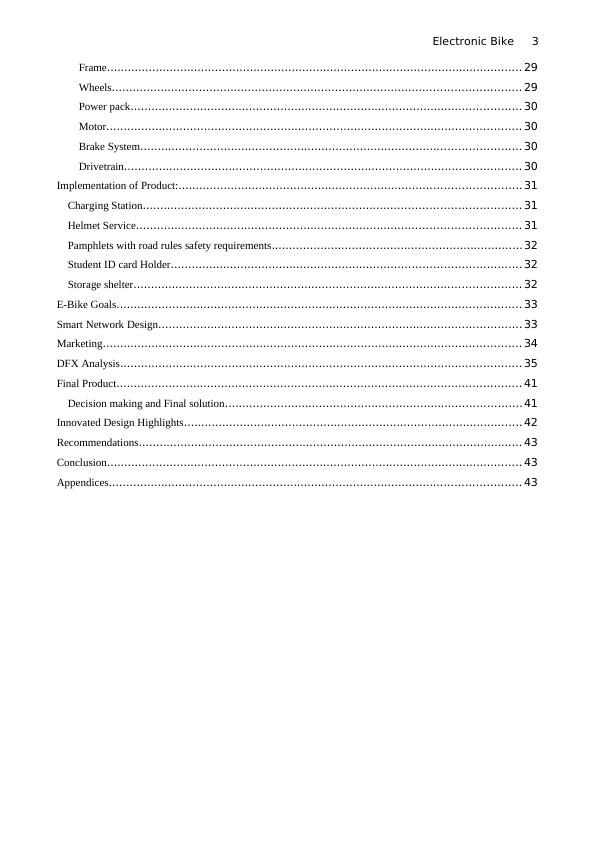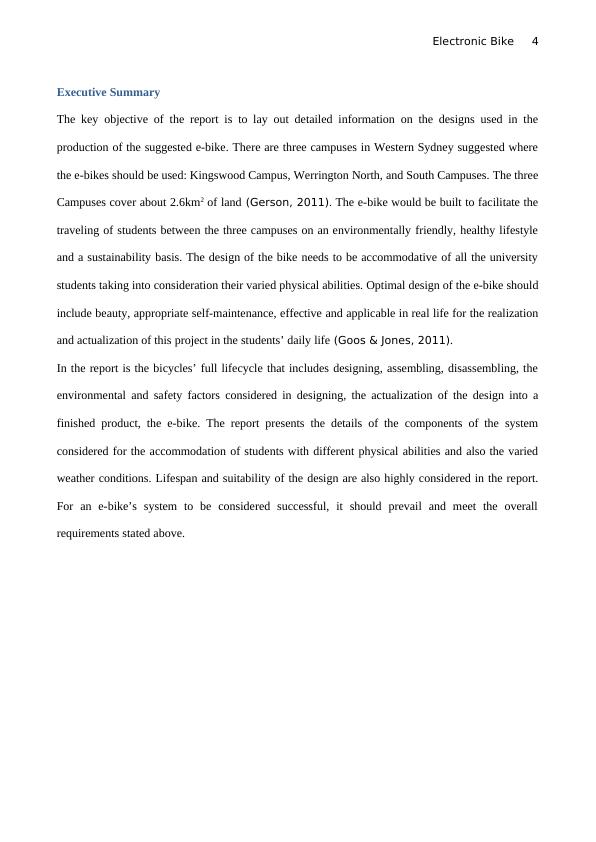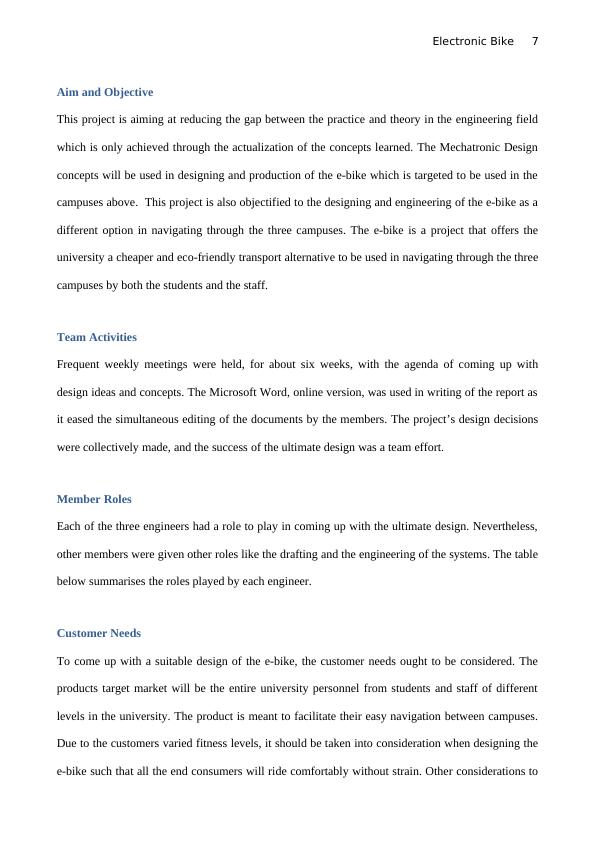Electronic Bike Assignment PDF
Added on 2021-05-31
70 Pages12733 Words37 Views
Electronic Bike 1
THE E-BIKE PROJECT
Author’s name
Class name
Tutors name
School name
City/state located
Date
THE E-BIKE PROJECT
Author’s name
Class name
Tutors name
School name
City/state located
Date

Electronic Bike 2
Contents
Executive Summary............................................................................................................. 3
Introduction....................................................................................................................... 3
Background........................................................................................................................ 4
Aim and Objective............................................................................................................... 5
Team Activities................................................................................................................... 5
Member Roles.................................................................................................................... 5
Customer Needs.................................................................................................................. 5
Project Design Goal............................................................................................................. 6
Performance Criteria............................................................................................................. 6
Initial E-Bike Design Concepts................................................................................................ 7
Legal Requirements.......................................................................................................... 7
Design Conception............................................................................................................ 8
Frame design................................................................................................................... 9
Front and Rear Wheel...................................................................................................... 10
Motor & Control Selections............................................................................................... 11
Drive Train................................................................................................................... 12
E-Bike interface............................................................................................................. 13
Preliminary sketches........................................................................................................ 14
Calculations.................................................................................................................. 15
General rider................................................................................................................. 16
Battery/Powerpack/Electric motor....................................................................................... 16
Material and Component Selection......................................................................................... 17
Frame............................................................................................................................. 17
Wheels........................................................................................................................ 20
Brakes......................................................................................................................... 20
Gears & Derailleur.......................................................................................................... 22
Lights and Splash Guards................................................................................................. 22
Motor.......................................................................................................................... 23
Power Source................................................................................................................... 24
CAD Analysis............................................................................................................... 25
Single Load Stress.......................................................................................................... 25
FMEA (Failure Mode & Effect Analysis)................................................................................. 26
Product and material Lifecycle.............................................................................................. 29
Damage to Materials....................................................................................................... 29
Contents
Executive Summary............................................................................................................. 3
Introduction....................................................................................................................... 3
Background........................................................................................................................ 4
Aim and Objective............................................................................................................... 5
Team Activities................................................................................................................... 5
Member Roles.................................................................................................................... 5
Customer Needs.................................................................................................................. 5
Project Design Goal............................................................................................................. 6
Performance Criteria............................................................................................................. 6
Initial E-Bike Design Concepts................................................................................................ 7
Legal Requirements.......................................................................................................... 7
Design Conception............................................................................................................ 8
Frame design................................................................................................................... 9
Front and Rear Wheel...................................................................................................... 10
Motor & Control Selections............................................................................................... 11
Drive Train................................................................................................................... 12
E-Bike interface............................................................................................................. 13
Preliminary sketches........................................................................................................ 14
Calculations.................................................................................................................. 15
General rider................................................................................................................. 16
Battery/Powerpack/Electric motor....................................................................................... 16
Material and Component Selection......................................................................................... 17
Frame............................................................................................................................. 17
Wheels........................................................................................................................ 20
Brakes......................................................................................................................... 20
Gears & Derailleur.......................................................................................................... 22
Lights and Splash Guards................................................................................................. 22
Motor.......................................................................................................................... 23
Power Source................................................................................................................... 24
CAD Analysis............................................................................................................... 25
Single Load Stress.......................................................................................................... 25
FMEA (Failure Mode & Effect Analysis)................................................................................. 26
Product and material Lifecycle.............................................................................................. 29
Damage to Materials....................................................................................................... 29

Electronic Bike 3
Frame....................................................................................................................... 29
Wheels..................................................................................................................... 29
Power pack................................................................................................................ 30
Motor....................................................................................................................... 30
Brake System............................................................................................................. 30
Drivetrain.................................................................................................................. 30
Implementation of Product:.................................................................................................. 31
Charging Station............................................................................................................ 31
Helmet Service.............................................................................................................. 31
Pamphlets with road rules safety requirements........................................................................32
Student ID card Holder.................................................................................................... 32
Storage shelter............................................................................................................... 32
E-Bike Goals.................................................................................................................... 33
Smart Network Design........................................................................................................ 33
Marketing........................................................................................................................ 34
DFX Analysis................................................................................................................... 35
Final Product.................................................................................................................... 41
Decision making and Final solution..................................................................................... 41
Innovated Design Highlights................................................................................................. 42
Recommendations.............................................................................................................. 43
Conclusion....................................................................................................................... 43
Appendices...................................................................................................................... 43
Frame....................................................................................................................... 29
Wheels..................................................................................................................... 29
Power pack................................................................................................................ 30
Motor....................................................................................................................... 30
Brake System............................................................................................................. 30
Drivetrain.................................................................................................................. 30
Implementation of Product:.................................................................................................. 31
Charging Station............................................................................................................ 31
Helmet Service.............................................................................................................. 31
Pamphlets with road rules safety requirements........................................................................32
Student ID card Holder.................................................................................................... 32
Storage shelter............................................................................................................... 32
E-Bike Goals.................................................................................................................... 33
Smart Network Design........................................................................................................ 33
Marketing........................................................................................................................ 34
DFX Analysis................................................................................................................... 35
Final Product.................................................................................................................... 41
Decision making and Final solution..................................................................................... 41
Innovated Design Highlights................................................................................................. 42
Recommendations.............................................................................................................. 43
Conclusion....................................................................................................................... 43
Appendices...................................................................................................................... 43

Electronic Bike 4
Executive Summary
The key objective of the report is to lay out detailed information on the designs used in the
production of the suggested e-bike. There are three campuses in Western Sydney suggested where
the e-bikes should be used: Kingswood Campus, Werrington North, and South Campuses. The three
Campuses cover about 2.6km2 of land (Gerson, 2011). The e-bike would be built to facilitate the
traveling of students between the three campuses on an environmentally friendly, healthy lifestyle
and a sustainability basis. The design of the bike needs to be accommodative of all the university
students taking into consideration their varied physical abilities. Optimal design of the e-bike should
include beauty, appropriate self-maintenance, effective and applicable in real life for the realization
and actualization of this project in the students’ daily life (Goos & Jones, 2011).
In the report is the bicycles’ full lifecycle that includes designing, assembling, disassembling, the
environmental and safety factors considered in designing, the actualization of the design into a
finished product, the e-bike. The report presents the details of the components of the system
considered for the accommodation of students with different physical abilities and also the varied
weather conditions. Lifespan and suitability of the design are also highly considered in the report.
For an e-bike’s system to be considered successful, it should prevail and meet the overall
requirements stated above.
Executive Summary
The key objective of the report is to lay out detailed information on the designs used in the
production of the suggested e-bike. There are three campuses in Western Sydney suggested where
the e-bikes should be used: Kingswood Campus, Werrington North, and South Campuses. The three
Campuses cover about 2.6km2 of land (Gerson, 2011). The e-bike would be built to facilitate the
traveling of students between the three campuses on an environmentally friendly, healthy lifestyle
and a sustainability basis. The design of the bike needs to be accommodative of all the university
students taking into consideration their varied physical abilities. Optimal design of the e-bike should
include beauty, appropriate self-maintenance, effective and applicable in real life for the realization
and actualization of this project in the students’ daily life (Goos & Jones, 2011).
In the report is the bicycles’ full lifecycle that includes designing, assembling, disassembling, the
environmental and safety factors considered in designing, the actualization of the design into a
finished product, the e-bike. The report presents the details of the components of the system
considered for the accommodation of students with different physical abilities and also the varied
weather conditions. Lifespan and suitability of the design are also highly considered in the report.
For an e-bike’s system to be considered successful, it should prevail and meet the overall
requirements stated above.

Electronic Bike 5
Introduction
The report on the e-bike design project shows the designing, mathematical application and the
production of the bike to facilitate the movement of the students located at the campuses in Penrith
Western Sydney. The incorporated design ideas include sustainable engineering, systems
engineering, DFM, DFA, DFD, FMEA, X designs and numerical simulation with computer-aided
design.
Background
E-bikes, majorly known by its electronically aided pedals, existed in the Australian market in the
past years but they became common with time to the present. E-bikes are one of the major share
contributors to the bicycle market (Morchin & Oman, 2006). Despite the improvement of
vehicles in the motor vehicle industry, bicycles remain to play a major role in the transport sector as
an easy and cheap mobility system for use. Most developed economies value the use of the bicycle
as a transport mode, for instance, the Chinese have made accessible bicycles to more than 200
million users who make use of them on a daily basis. The main advantage of using a bicycle is that
there is zero damage to the environment in the sense of pollution and other factors. However, there
is a lot of strain on the user and unfitness which disadvantages the cycling exercise. The project
seeks to solve the problem and hence provide ease transportation and accessibility to the entire
population.
In the Late 19th century, there emerged the first e-bikes, but unfortunately, despite patenting their
designs, there was no mass production of the e-bikes hence it was unavailable for the public (Friss,
2015). A century later there came up new developments where torque sensors were incorporated
into the original design and hence improved the user-friendliness of the technology. Commercial e-
Introduction
The report on the e-bike design project shows the designing, mathematical application and the
production of the bike to facilitate the movement of the students located at the campuses in Penrith
Western Sydney. The incorporated design ideas include sustainable engineering, systems
engineering, DFM, DFA, DFD, FMEA, X designs and numerical simulation with computer-aided
design.
Background
E-bikes, majorly known by its electronically aided pedals, existed in the Australian market in the
past years but they became common with time to the present. E-bikes are one of the major share
contributors to the bicycle market (Morchin & Oman, 2006). Despite the improvement of
vehicles in the motor vehicle industry, bicycles remain to play a major role in the transport sector as
an easy and cheap mobility system for use. Most developed economies value the use of the bicycle
as a transport mode, for instance, the Chinese have made accessible bicycles to more than 200
million users who make use of them on a daily basis. The main advantage of using a bicycle is that
there is zero damage to the environment in the sense of pollution and other factors. However, there
is a lot of strain on the user and unfitness which disadvantages the cycling exercise. The project
seeks to solve the problem and hence provide ease transportation and accessibility to the entire
population.
In the Late 19th century, there emerged the first e-bikes, but unfortunately, despite patenting their
designs, there was no mass production of the e-bikes hence it was unavailable for the public (Friss,
2015). A century later there came up new developments where torque sensors were incorporated
into the original design and hence improved the user-friendliness of the technology. Commercial e-

Electronic Bike 6
bikes were later commercially produced which lead to the Panasonic and Yamaha companies
(Anon., 2009).
The e-bike’s popularity is major as a result of the society’s conscience on matters health. The world
is growing technologically to the designing of more smart devices that are integrated to make
human’s life easy and hence the need of the e-bikes. Also, the e-bike’s running cost is relatively
cheaper compared to petrochemical vehicles, and hence this has contributed to its popularity. With
these popularity reasons, the e-bike is necessary to facilitate transport as an alternative to other
forms of transport (Kroesen, 2017).
bikes were later commercially produced which lead to the Panasonic and Yamaha companies
(Anon., 2009).
The e-bike’s popularity is major as a result of the society’s conscience on matters health. The world
is growing technologically to the designing of more smart devices that are integrated to make
human’s life easy and hence the need of the e-bikes. Also, the e-bike’s running cost is relatively
cheaper compared to petrochemical vehicles, and hence this has contributed to its popularity. With
these popularity reasons, the e-bike is necessary to facilitate transport as an alternative to other
forms of transport (Kroesen, 2017).

Electronic Bike 7
Aim and Objective
This project is aiming at reducing the gap between the practice and theory in the engineering field
which is only achieved through the actualization of the concepts learned. The Mechatronic Design
concepts will be used in designing and production of the e-bike which is targeted to be used in the
campuses above. This project is also objectified to the designing and engineering of the e-bike as a
different option in navigating through the three campuses. The e-bike is a project that offers the
university a cheaper and eco-friendly transport alternative to be used in navigating through the three
campuses by both the students and the staff.
Team Activities
Frequent weekly meetings were held, for about six weeks, with the agenda of coming up with
design ideas and concepts. The Microsoft Word, online version, was used in writing of the report as
it eased the simultaneous editing of the documents by the members. The project’s design decisions
were collectively made, and the success of the ultimate design was a team effort.
Member Roles
Each of the three engineers had a role to play in coming up with the ultimate design. Nevertheless,
other members were given other roles like the drafting and the engineering of the systems. The table
below summarises the roles played by each engineer.
Customer Needs
To come up with a suitable design of the e-bike, the customer needs ought to be considered. The
products target market will be the entire university personnel from students and staff of different
levels in the university. The product is meant to facilitate their easy navigation between campuses.
Due to the customers varied fitness levels, it should be taken into consideration when designing the
e-bike such that all the end consumers will ride comfortably without strain. Other considerations to
Aim and Objective
This project is aiming at reducing the gap between the practice and theory in the engineering field
which is only achieved through the actualization of the concepts learned. The Mechatronic Design
concepts will be used in designing and production of the e-bike which is targeted to be used in the
campuses above. This project is also objectified to the designing and engineering of the e-bike as a
different option in navigating through the three campuses. The e-bike is a project that offers the
university a cheaper and eco-friendly transport alternative to be used in navigating through the three
campuses by both the students and the staff.
Team Activities
Frequent weekly meetings were held, for about six weeks, with the agenda of coming up with
design ideas and concepts. The Microsoft Word, online version, was used in writing of the report as
it eased the simultaneous editing of the documents by the members. The project’s design decisions
were collectively made, and the success of the ultimate design was a team effort.
Member Roles
Each of the three engineers had a role to play in coming up with the ultimate design. Nevertheless,
other members were given other roles like the drafting and the engineering of the systems. The table
below summarises the roles played by each engineer.
Customer Needs
To come up with a suitable design of the e-bike, the customer needs ought to be considered. The
products target market will be the entire university personnel from students and staff of different
levels in the university. The product is meant to facilitate their easy navigation between campuses.
Due to the customers varied fitness levels, it should be taken into consideration when designing the
e-bike such that all the end consumers will ride comfortably without strain. Other considerations to

Electronic Bike 8
be looked at include the physical appearance of the e-bike whether it would be appealing to the
user, users with different weights of about 40 kilograms to 160 kilograms, a well-designed control
interface that will ease use and not gender biased. Attaining all the customer needs means success to
the design and production of the product.
Project Design Goal
The major design goal for this project is to produce a bicycle that is electrically aided which would
help persons of different levels of fitness to navigate around the campuses, also reducing CO2
production and emission by the adoption of renewable sources of energy and use of fossil fuels in
recharging of batteries (Fyhri, 2015). Students should be entitled to this mode of transport to
improve their health, through working out/exercising using this specific mode of transport and
discourage the common unhealthy student lifestyle. For the maximum utilization of the mode of
transport, the bike should be able to withstand all weather conditions that it is likely to be subjected
to. For instance, for the sake of rains, the bike should be waterproof and resist corrosion since it is
usually used outdoors. Legal necessities must be accomplished as the bike’s target market would be
students and they should not require regular licensing and registration to increase the usability of
this product across the universities. The set goals to be achieved at the end of this project would be
to use all the design knowledge in coming up with an efficient, usable product that will have
satisfied all the consumers’ needs. A smart campus will be built in the process around the Western
Sydney region.
Performance Criteria
It is desired that the e-bike should be able to perform in areas such as: when fully charged, and
carrying a maximum load of 150 Kg (Edge, 2018), the e-bike should continuously be cycled from
Kingswood grounds to Werrington South grounds and Werrington North Grounds. .the bike should
sustain a maximum of 4km which is considered the distance between Kingswood grounds car park
be looked at include the physical appearance of the e-bike whether it would be appealing to the
user, users with different weights of about 40 kilograms to 160 kilograms, a well-designed control
interface that will ease use and not gender biased. Attaining all the customer needs means success to
the design and production of the product.
Project Design Goal
The major design goal for this project is to produce a bicycle that is electrically aided which would
help persons of different levels of fitness to navigate around the campuses, also reducing CO2
production and emission by the adoption of renewable sources of energy and use of fossil fuels in
recharging of batteries (Fyhri, 2015). Students should be entitled to this mode of transport to
improve their health, through working out/exercising using this specific mode of transport and
discourage the common unhealthy student lifestyle. For the maximum utilization of the mode of
transport, the bike should be able to withstand all weather conditions that it is likely to be subjected
to. For instance, for the sake of rains, the bike should be waterproof and resist corrosion since it is
usually used outdoors. Legal necessities must be accomplished as the bike’s target market would be
students and they should not require regular licensing and registration to increase the usability of
this product across the universities. The set goals to be achieved at the end of this project would be
to use all the design knowledge in coming up with an efficient, usable product that will have
satisfied all the consumers’ needs. A smart campus will be built in the process around the Western
Sydney region.
Performance Criteria
It is desired that the e-bike should be able to perform in areas such as: when fully charged, and
carrying a maximum load of 150 Kg (Edge, 2018), the e-bike should continuously be cycled from
Kingswood grounds to Werrington South grounds and Werrington North Grounds. .the bike should
sustain a maximum of 4km which is considered the distance between Kingswood grounds car park

End of preview
Want to access all the pages? Upload your documents or become a member.
Related Documents
Mechanical Design for Smart E-Bike: Design, Analysis, and Manufacturinglg...
|53
|6959
|73
Design of an Electric Bike: Conceptual and Final Designlg...
|44
|6476
|123
Introduction to Mechanical Engineering | Studylg...
|50
|9695
|62
Design and Development of Quadcopter for Advanced Manufacturing-IIlg...
|42
|11891
|479
Design Principles for E-Bikes at Western Sydney Universitylg...
|36
|9617
|457
ADVANCE ENGINEERING PROJECT ONE.lg...
|53
|12531
|4
